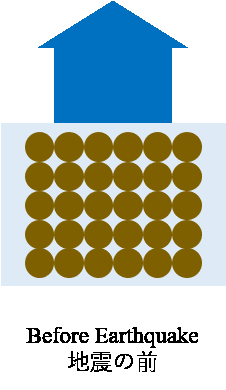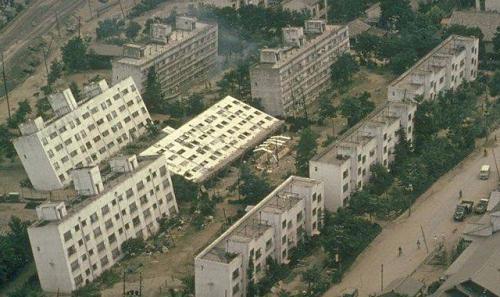What is Soil Liquefaction?
When earthquakes cause strong ground movements, these cyclic motions can cause the soil near the ground surface to loosen up very quickly. Liquefaction is generally observed in LOOSE, SATURATED (wet), COHESIONLESS soil (i.e. granular soils, primarily sand).

An animation illustrating the process of liquefaction is shown below.

As the shaking begins, the soil particles lose contact between one another, allowing excess pore water pressure to float water particles to the top. After the earthquake, the soil particles reorganise and settle, and residual excess water will rise to the top.
Dangers of Soil Liquefaction
Liquefaction causes the loose soil to lose bearing strength and stiffness, leading to significant settlement of the soil. It is usually localised, so the soil under only one area of the building may settle, leading to serious differential settlement and therefore building damage. A famous example is shown in the image below from the 1964 Niigata Earthquake.

Conditions for Soil Liquefaction
When assessing the vulnerability of the soil to liquefaction, we usually consider just the first 20 m of ground. This soil may be vulnerable to liquefaction provided several different conditions hold true:
- Sandy soil with particle sizes ranging from 0.03- to 0.5 mm
- High water table (closer than 10 m from the ground level)
- Percentage of very fine soil particles (clay and silt, < 0.075 mm) are less than 35%
- Soil Plasticity Index (PI) is 15% or below
- SPT-N value is less than 20
Another indication is when the shear wave velocity of the soil, Vs,30 ≦ 150 m/s. Soil with shear velocities in excess of 200 m/s generally have little history of liquefaction.
※ What is the Soil Plasticity Index?
※ What is the Shear Wave Velocity?
Mitigation Measures
There are several methods available to avoid the damaging effects of soil liquefaction. A combination of these methods are usually used in practice.
The suggested methods are as follows: (a). Use a mat slab foundation to bear over the vulnerable area safely; (b). Provide foundation tie beams to ensure the entire structure settles evenly and strength is shared between the footings; (c). Use pile foundations to bear on a firm layer below the soil layers vulnerable to liquefaction; and, (d). Use ground improvement methods to avoid the risk of soil liquefaction.
Further Reading
You can view more information about soil liquefaction at the links below:
- Obayashi Corportation - Liquefaction (Japanese)
- Osaka Prefecture - Liquefaction Assessment and Mitigation (Japanese)
- Ota City - Liquefaction Guidelines (Japanese)